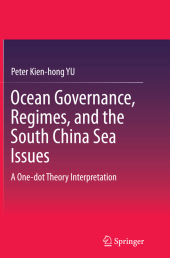 Neuerscheinungen 2016Stand: 2020-02-01 |
Schnellsuche
ISBN/Stichwort/Autor
|
Herderstraße 10
10625 Berlin
Tel.: 030 315 714 16
Fax 030 315 714 14
info@buchspektrum.de |

Peter Kien-hong Yu
Ocean Governance, Regimes, and the South China Sea Issues
A One-dot Theory Interpretation
Softcover reprint of the original 1st ed. 2015. 2016. xiii, 269 S. 26 SW-Abb. 235 mm
Verlag/Jahr: SPRINGER, BERLIN; SPRINGER SINGAPORE; SPRINGER 2016
ISBN: 9811012725 (9811012725)
Neue ISBN: 978-9811012723 (9789811012723)
Preis und Lieferzeit: Bitte klicken
This book uses Chinese version of dialectics to present interpretations of ocean governance, international regimes, issues in the South China Sea in general and the Chinese U-shaped line in particular, through the one-dot theory. It especially serves as a tool for non-Chinese researchers and experts interested in analyzing international relations issues from a Chinese perspective. The dialectical one-dot theory, which is a superior model to the dialectical Yin and Yang or the dialectical crab and frog motion model, provides research and findings that more closely mirror reality than do other, non-dialectical approaches and research methods. Further, it can be applied to both the natural and social sciences. The book is divided into three parts - Methodology, Case Studies Related to International Regimes and Non-"International Regimes," and Issues Related to the U-shaped Line in the South China Sea - with each chapter structured in terms of the one-dot theory. In addition to researchers and experts involved in marine and maritime affairs, this book will also appeal to all readers interested in Chinese Philosophy, International Relations, and Strategic Culture.
Preface.- Part I: Methodology: Approaches and Research Methods.- Chapter 1: Introduction: One-dot Theory Described, Explained, Inferred, Justified, and Applied.- Chapter 2: Non-"dialectical" Levels (or Dialectical Scale) of Ocean Governance.- Chapter 3: Ocean Governance and International Regimes: A One-dot Theory Conversion and/or Reinvention.- Part II: Case Studies Related to International Regimes and Non-"International Regimes".- Chapter 4: The International Regimes Dimension of the UNCLOS: Slot in the Information and Analysis.- Chapter 5: The International Regimes Dimension of Waterways and Straits: Slot in the Information and Analysis.- Chapter 6: The Regime for Highly Migratory Fish Stocks and Straddling Fish Stocks: Slot in the Information and Analysis.- Chapter 7: A Consultation Mechanism to Strengthen Military Maritime Safety between Beijing and Washington: Slot in the Information and Analysis.- Chapter 8: Forming, Maintaining, and Sustaining International (Adversary) Regimes in the South China Sea: Analyzing Some Obstacles from a Chinese Perspective.- Chapter 9: International Regimes and Maritime Commons in the South China Sea: A One-dot Theory Interpretation.- Chapter 10: The Chinese Historic Waters as an Exceptional Regime in Ocean Development.- Part III: Issues Related to the U-shaped Line in the South China Sea.- Chapter 11: China: From One Dot to Another Dot.- Chapter 12: The Chinese U-shaped Line: A Dialectically Presented Sample.- Chapter 13: In Defense of the Chinese U-shaped Line: Applying the Chinese Ideogram, , for the Explication.- Chapter 14: A One-dot Theory Critique of the UNCLOS: Is the Chinese U-shaped Line Really Infamous?.- Part IV: Conclusion.- Chapter 15: Concluding Remarks.- Bibliography.- Appendix.


